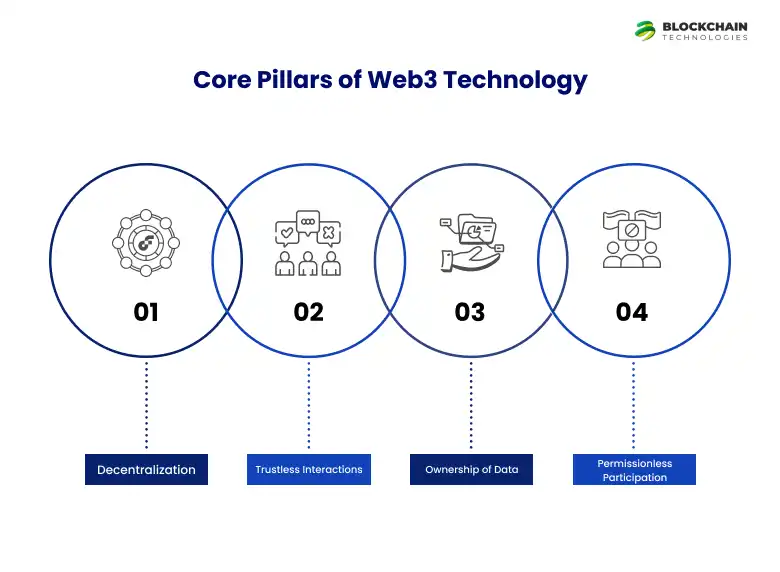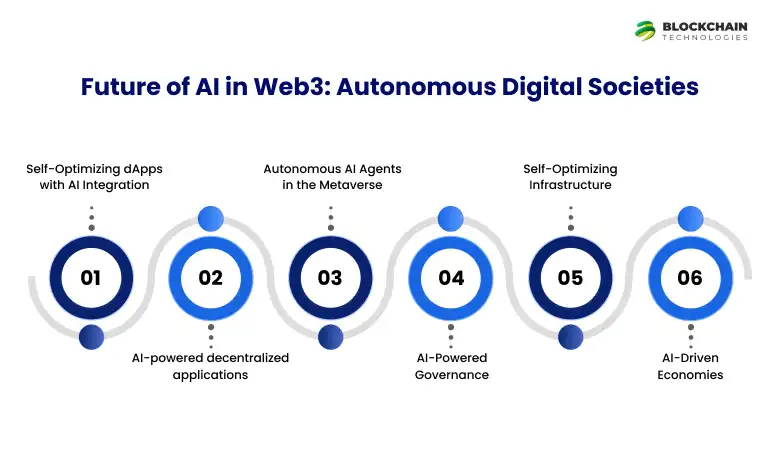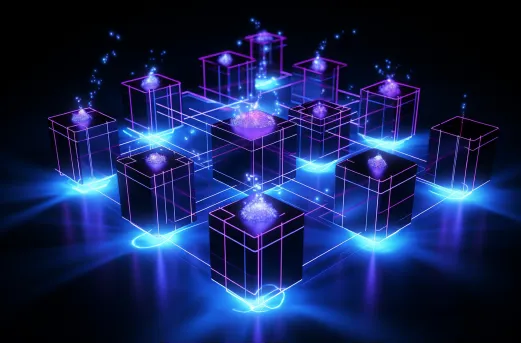AI in Web3: Bridging Intelligence and Decentralization
May 29,2025
The internet is undergoing a groundbreaking transformation, moving from the centralized systems of Web 2.0 to the decentralized, user-governed ecosystems of Web3. Fueled by innovations in blockchain and decentralized protocols, Web3 technology is redefining how we interact, transact, and trust in the digital world. But there’s a new catalyst that’s accelerating this shift even further- AI in Web3.
By integrating artificial intelligence in Web3, we’re unlocking an internet that’s not only decentralized but also intelligent, automated, and adaptive.
- According to Marketsandmarkets, The global Web 3.0 market is projected to grow from USD 0.4 billion in 2023 to USD 5.5 billion by 2030, at a compound annual growth rate (CAGR) of 44.9%.
- The global artificial intelligence (AI) market is expected to reach USD 1.8 trillion by 2030, growing at a CAGR of 35.9% from 2025 to 2030. (Grand View Research)
- According to Marketsandmarkets , The global Web 3.0 market is projected to grow from USD 0.4 billion in 2023 to USD 5.5 billion by 2030, at a compound annual growth rate (CAGR) of 44.9%.
- The global artificial intelligence (AI) market is expected to reach USD 1.8 trillion by 2030, growing at a CAGR of 35.9% from 2025 to 2030. (Grand View Research)
Now, imagine combining these two revolutionary forces. The result? A future powered by smart, autonomous, and trustless systems that reshape digital interactions, where AI-powered dApps, Blockchain AI integration, and decentralized AI governance using DAOs become everyday reality.
In this blog, we’ll explore the convergence of Web3 and artificial intelligence, understand how AI enhances Web3 experiences, and spotlight real-world use cases of AI for decentralized applications. Let’s dive into the exciting universe of AI in Web3.
What is Web3: A Decentralized Evolution of the Internet
The internet we use today is social media, cloud storage, and online shopping, is largely built on Web 2.0, a version of the internet dominated by centralized platforms like Google, Facebook, and Amazon. But this structure gives immense power and control to a few corporations. Enter Web3 technology, the next generation of the internet, focused on decentralization, trustless interactions, and true data ownership.
So, what is Web3 exactly? Let’s break it down step-by-step, technically and conversationally.
From Web 1.0 to Web3: The Internet's Evolution
Before diving into the role of AI in Web3, it’s important to understand how we got here.
- Web 1.0 (Static Web) – The early internet (1990s): Read-only websites, minimal interaction.
- Web 2.0 (Social Web) – Mid-2000s onward: Interactive content, user-generated data, social media, but centralized.
- Web3 (Decentralized Web) – Now emerging: Peer-to-peer, open-source, governed by users, not tech giants.
- Web3 technology - Blockchain networks, decentralized storage, cryptographic security, and smart contracts to ensure transparency and user autonomy.
Core Pillars of Web3 Technology

- Decentralization No single entity controls the data or applications. Everything is distributed across blockchain networks.
- Trustless Interactions Users interact via smart contracts, automated, tamper-proof agreements with no intermediaries.
- Ownership of Data Users have control over their digital identities, assets, and content via wallets and decentralized identities (DIDs).
- Permissionless Participation Anyone can build, use, and participate in the network, open-source by design.
Role of AI in Web3: Intelligence + Decentralization
So, how AI Enhances Decentralized Applications in Web3 in reshaping the digital world. By bringing together the analytical and learning power of artificial intelligence with the transparency and autonomy of Web3 technology, we enable next-gen applications that are smart, secure, and self-governing.
From building AI-powered dApps in Web3 to creating privacy-preserving AI models in decentralized networks, this synergy is redefining what’s possible on the decentralized web.
Let’s break down why this convergence is reshaping the future of the internet.

Data Analysis and Personalization
In a decentralized landscape, personalization doesn’t come from user profiling by centralized entities, it’s powered by AI-driven analytics that respects data ownership.
- On-Chain and Off-Chain Data Mining: AI in Web3 ecosystems like Lens Protocol or Mirror.xyz use natural language processing and clustering models to analyze user interactions, token use, and NFT engagement for building a contextual content graph.
- Hyper-Personalized dApps: Machine learning models generate real-time recommendations across AI-powered decentralized applications, enabling tailored financial insights in DeFi, custom DAO proposals, or dynamic content in Web3 social platforms.
- Federated Learning + Token Incentives: Instead of centralized data collection, federated AI models trained across nodes help personalize experiences while preserving privacy. Blockchain app development companies like Blockchaintechs.io are integrating token-based incentives to encourage user participation in training data sharing.
Behavioral Analysis
So, how AI Enhances Decentralized Experiences Through Behavioral Analysis AI-powered dApps in Web3 are transforming passive users into active participants by personalizing interactions. Here’s how:
- On-Chain Behavioral Analytics: Machine learning models analyze transaction histories, wallet activity, and DAO voting patterns to tailor experiences. For example, AI for decentralized applications like Brave Browser uses ML to recommend personalized NFT collections or DeFi protocols based on user behavior.
- Dynamic Content Delivery: Reinforcement learning algorithms optimize content feeds in decentralized social media platforms (e.g., Mastodon), prioritizing posts aligned with user engagement patterns.
- Predictive User Interfaces: AI enhances Web3 experiences by anticipating user needs, think MetaMask suggesting gas fee optimizations based on network congestion data.
AI models trained on zero-party data (user-shared via decentralized identity protocols) ensure privacy while delivering hyper-relevant experiences.
Decentralized Ledgers:
- AI-Driven Threat Detection: Anomaly detection algorithms (e.g., Elliptic’s AML tools) monitor blockchain transactions in real-time, flagging suspicious patterns like rug pulls or wash trading.
- Self-Healing Networks: Blockchain AI integration enables networks like Helium to autonomously reroute data traffic during outages using ML-predicted node failures.
- Immutable Audits: AI audits smart contract code for vulnerabilities (e.g., CertiK’s Skynet), while blockchain logs every audit step transparently.
AI in Smart Contracts
So, how AI Empowers Autonomous Smart Contracts in Web3. Traditional smart contracts follow static rules. Integrating AI into smart contracts makes them adaptive, intelligent, and capable of learning from previous interactions.
- Predictive Execution Logic: AI models continuously monitor oracles, market data, and network traffic. Smart contracts automatically adjust logic based on learned patterns, like auto-pausing yield farming strategies in volatile conditions.
- Generative Smart Contracts: Using reinforcement learning and machine learning in Web3, some platforms now generate new contract logic based on ecosystem trends, user feedback, and DAO analytics.
- DAO-Driven Contract Upgrades: AI can propose real-time improvements in smart contract terms based on sentiment analysis from community channels or DAO voting outcomes.
Privacy-Preserving AI Models
Privacy-preserving AI models in decentralized networks solve the “data vs. privacy” paradox:
- Federated Learning: Models train across distributed nodes without raw data leaving user devices. Healthcare AI dApps like Doc.ai use this to analyze patient data across hospitals without breaching HIPAA.
- Homomorphic Encryption: Zama.ai enables AI to analyze encrypted blockchain data (e.g., private DeFi trades), returning results without decryption.
- zkML (Zero-Knowledge Machine Learning): Projects like Modulus Labs let users verify AI outputs (e.g., NFT valuations) without revealing the model’s weights, blending AI and blockchain synergy.
zk-SNARKs prove computational integrity, allowing AI inferences to be trusted without exposing sensitive inputs.
Security and Fraud Detection
How AI Strengthens Security in Decentralized Ecosystems. Security in Web3 is about anticipating threats and adapting. This is where AI for decentralized applications steps in with proactive intelligence.
- Behavioral Anomaly Detection: AI detects irregular wallet activities or suspicious token movements using unsupervised learning. Projects like OpenZeppelin Defender already implement AI modules for real-time security alerts.
- DeFi Risk Scoring Engines: Machine learning analyzes historical smart contract breaches and assigns dynamic risk scores to new protocols, aiding safer investments.
- Sybil Attack Prevention: AI identifies Sybil attacks in decentralized identity systems by analyzing behavioral anomalies, connection patterns, and unusual activity bursts across wallet addresses.
Intersection: AI in Blockchain Integration
- Decentralized Identity (DID): AI and Web3 in decentralized finance (DeFi) enable DID systems (e.g., SpruceID) where ML algorithms verify credentials without third parties. Imagine a loan approval where AI analyzes your on-chain credit score stored on Ceramic Network.
- AI-Curated Marketplaces: Platforms like Audius use NLP models to recommend music NFTs, while Ocean Protocol’s AI agents match datasets with researchers.
- Autonomous Organizations: Decentralized AI governance using DAOs allows Aragon-based DAOs to deploy AI tools that automate treasury management or proposal analysis.
Why This Convergence Is Non-Negotiable for Web3’s Future
Without AI, Web3 risks becoming a clunky, static ecosystem. Without Web3, AI remains centralized and opaque. Together, they solve each other’s flaws:
- Ethical AI: Decentralized AI governance ensures models are auditable and aligned with community ethics (e.g., SingularityNET’s DAO-voted AI objectives).
- Scalable Intelligence: Web3 with ML technology distributes AI training across nodes (via Gensyn’s compute protocols), slashing costs and energy use.
- User Empowerment: AI-powered dApps like DIMO turn users from data commodities into data owners, rewarding them for contributing to AI training.
In short, AI in Web3 is the backbone of a web that’s truly by the people, for the people.
Ready for a Smarter Web?
Imagine decentralized internet powered by AI. The future is here, are you ready to join in?
Web3 with ML Technology: Adaptive Learning in Decentralized Networks
The convergence of Web3 with ML technology marks a significant leap in creating intelligent decentralized systems. Machine learning in Web3 allows platforms to continuously learn and optimize in real-time, without relying on central authorities. Insights are embedded into smart contracts or decentralized services for continual refinement.
How Web3 and Machine Learning Work Together:
- Decentralized nodes collect and exchange data.
- ML models process this data locally or via federated learning techniques.
Key ML Use Cases in Web3:
- Content Recommendation in Decentralized Media Platforms: On-chain streaming or social dApps personalize user feeds and recommendations using collaborative filtering and deep learning techniques.
- Predictive Token Economics in Blockchain Ecosystems: ML analyzes token velocity, user participation, and trading patterns to optimize tokenomics, preventing inflation and promoting sustainability.
- Decentralized AI Agents in the Metaverse: Autonomous AI agents equipped with reinforcement learning operate within virtual worlds, making split-second decisions based on user behavior, game theory, and network dynamics.
This intelligent infrastructure empowers self-evolving systems and represents a crucial shift toward adaptive, intelligent decentralized networks, a major breakthrough in the AI and blockchain synergy narrative.
Applications – AI-Driven Web3 Universe Use Cases with Decentralized AI
The fusion of AI in Web3 is transforming the decentralized digital universe by embedding intelligence directly into blockchain ecosystems. This integration enables decentralized applications (dApps) and autonomous networks to function with greater efficiency, security, and personalization. Leveraging decentralized AI, these systems break traditional centralized constraints and empower users with more control and smarter services.
Let’s dive into three pivotal AI-driven Web3 use cases that showcase how decentralized AI revolutionizes industries:

1. Decentralized Finance (DeFi) with AI-Powered Risk Management
AI models ingest real-time market data, on-chain transaction flows, and historical user behavior to predict risks and dynamically adjust parameters such as collateral requirements or interest rates. Using techniques like reinforcement learning, these models optimize for maximizing yield while minimizing systemic risk.
Example: Platforms like Aave and Compound are experimenting with AI-driven modules that autonomously recalibrate lending pools based on predictive analytics. This reduces liquidation events and improves the platform’s overall stability without manual intervention.
2. AI-Enhanced Identity Verification in Decentralized Networks
One of Web3’s core promises is user sovereignty over identity, but verifying identity without centralized authorities remains a complex issue. Enter AI-powered decentralized identity systems, which combine biometric AI, zero-knowledge proofs (ZKP), and blockchain immutability to create secure, privacy-preserving verification methods.
AI algorithms analyze biometric inputs (like facial recognition or voice patterns) locally on user devices to generate encrypted proofs without exposing raw data. These proofs are then validated on-chain using ZKP protocols, ensuring trust without sacrificing user privacy. Federated learning approaches enable continuous AI model improvement without centralized data collection.
Example: Projects like Civic and SelfKey leverage AI-enhanced identity verification to facilitate secure KYC (Know Your Customer) compliance for DeFi onboarding, making processes seamless and compliant with regulations while maintaining decentralization.
3. Decentralized Autonomous Organizations (DAOs) with AI-Driven Governance
DAOs represent the future of organizational management on the blockchain, but as they scale, governance complexity grows. Incorporating AI-driven governance tools enables DAOs to make smarter, data-informed decisions while enhancing community participation.
AI models perform natural language processing (NLP) to analyze proposals, community sentiment, and historical voting patterns. Predictive analytics forecast proposal outcomes, flag potential governance attacks or vote manipulations, and recommend strategic changes to improve effectiveness. These insights are fed into DAO smart contracts to automate routine decisions or suggest optimal voting schedules.
Example: The Aragon and Moloch DAO ecosystems are integrating AI modules to help filter and prioritize proposals, detect vote-buying attempts, and provide transparent analytics dashboards for members, thus enhancing governance efficiency and fairness.
4. Decentralized AI governance using DAOs
Decentralized AI governance using DAOs is replacing slow, bureaucratic decision-making with agile, data-driven processes. Sentiment Analysis: NLP models (e.g., GPT-4) parse forum discussions and Discord chats to gauge member sentiment.
ML predicts voting outcomes by analyzing historical DAO behavior (e.g., Aragon’s AI governance toolkit). Smart contracts trigger actions (e.g., fund disbursements) based on AI-verified metrics (e.g., DAOstack’s decentralized analytics).
Example: Uniswap DAO uses AI-powered dApps like DeepDAO to prioritize protocol upgrades. Before a vote, AI scans GitHub commits, forum debates, and past proposals to predict which changes will pass, reducing voter fatigue by 60%.
Don't Get Left Behind in the Web3 Evolution!
AI is the missing piece,bringing intelligence and automation to the Decentralized web. Explore the potential with Blockchaintechs.io.
AI Challenges, Web3 Solutions: Redefining Ethics and Control
The rise of AI in Web3 brings unprecedented opportunities, and complex challenges. Centralized AI systems often prioritize profit over ethics, hoarding data, obscuring decision-making, and exploiting contributors. But decentralized AI governance and blockchain’s inherent transparency are flipping the script. Let’s dissect the biggest AI pain points and how Web3 artificial intelligence is solving them.

1. Privacy Risks:
Centralized AI giants like Google and Meta amass user data in vulnerable silos, risking breaches (e.g., 533M Facebook records leaked in 2021).
Web3 Fixes:
- Federated Learning: Models train locally on user devices (e.g., smartphones) and share only encrypted updates. Projects like Oasis Network use this to analyze healthcare data across hospitals without exposing patient records. Example: Doc.ai trains diagnostic AI on federated data from 10M+ users, ensuring HIPAA compliance.
-
Homomorphic Encryption (HE): Data stays encrypted during AI processing. Zama.ai’s fhEVM enables privacy-preserving AI models to compute on encrypted blockchain transactions.
Example: A DeFi platform uses HE to assess creditworthiness without seeing users’ income or transaction history. - Zero-Knowledge Data Markets: Platforms like Numerai let users stake data anonymously via zk-SNARKs, earning NMR tokens if their data improves model accuracy.
2. Model Bias & Opacity:
Closed-source models like GPT-4 hide training data and logic, leading to biased outputs (e.g., racial profiling in facial recognition).
Web3 Fixes:
-
On-Chain Model Registries: AI architectures and training data hashes are stored on IPFS/Arweave, auditable via smart contracts. SingularityNET’s decentralized marketplace publishes model metadata on Ethereum.
Example: A DAO votes to delist a biased hiring algorithm after auditing its on-chain training data sources. - Decentralized Validation: Braintrust uses a network of validators to test AI models for fairness, rewarding them with BTRST tokens.
- zkML (Zero-Knowledge Machine Learning): Modulus Labs proves model fairness via zk-SNARKs—without revealing proprietary code. Example: An NFT valuation AI proves it didn’t unfairly favor blue-chip collections, boosting trust in AI-powered dApps.
3. Ownership Disputes:
Platforms like Midjourney claim ownership over AI-generated art, while contributors get nothing.
Web3 Fixes:
- Data NFTs: Users mint datasets as NFTs on Ocean Protocol, earning royalties each time they’re used in AI training. Example: A musician’s voice samples, tokenized as an NFT, train a vocal AI—with 10% royalties paid automatically via smart contract.
-
Tokenized Contributions: Bittensor rewards users with TAO tokens for contributing compute power to its decentralized AI network.
Example: A researcher earns tokens for improving a medical diagnosis model, tracked via blockchain AI integration. - Decentralized IP Ownership: AI dApps like Giza assign ownership of AI-generated content (e.g., code, art) to creators via soulbound tokens (SBTs).
4. Ethical Governance:
A handful of executives decide how AI impacts society (e.g., OpenAI’s closed governance).
Web3 Fixes:
- DAO Audits: Fetch.ai’s CO2 token lets DAOs vote to offset AI’s carbon footprint, with emissions tracked on-chain. Example: A climate DAO penalizes energy-intensive AI models by slashing their staked tokens.
- Community-Driven Model Training: Hugging Face’s decentralized platform lets users vote on which datasets to prioritize for ethical AI training.
- Incentivized Ethics: Gitcoin funds public-goods AI projects (e.g., open-source medical models) via quadratic voting.
AI and Web3: The Perfect Partnership!
Explore AI-powered dApps and decentralized AI solutions with leading blockchain AI integration experts.
Future of AI in Web3: Autonomous Digital Societies
The fusion of AI in Web3 is steering us toward autonomous digital societies, self-managed ecosystems where decentralized AI and blockchain collaborate to govern resources, enforce rules, and innovate without central oversight. Here’s a snapshot:

Let’s explore the emerging trends and innovations that will shape the future of Web3-based data storage solutions.
- Self-Optimizing dApps with AI Integration: As AI-powered decentralized applications (dApps) mature, they’ll become truly autonomous, learning from every interaction and adapting in real-time.
- Autonomous AI Agents in the Metaverse: As Web3 metaverse platforms evolve, AI agents will serve as personal assistants, negotiators, entertainers, and more, traversing decentralized platforms autonomously.
- AI-Powered Governance: Decentralized AI governance tools like Aragon AI optimize DAO decision-making. Example: MakerDAO uses ML to simulate policy impacts, slashing deliberation time.
- Self-Optimizing Infrastructure: Smart grids (e.g., LO3 Energy) use federated learning on IPFS to balance renewable energy trades.
- AI-Driven Economies: AI-powered dApps like Numerai predict DeFi trends, while Ocean Protocol’s data NFTs monetize insights.
Wrapping Up:
As the lines between intelligence and decentralization blur, the convergence of AI and Web3 is set to redefine the very fabric of the internet. From predictive DAOs to self-optimizing dApps and AI-powered decentralized agents, we are entering an era where technology is not only trustless but also truly intelligent.
Why Partner with Blockchaintechs.io?
- 1. Expertise in AI-Driven Web3 Architecture
- 2. Future-Proof Solutions for Emerging Trends
- 3. Scalability Meets Security
- 4. Proven Success in Cutting-Edge Projects
As we march toward autonomous digital societies, the collaboration between AI and blockchain will define industries, economies, and governance. The bottom line: AI in Web3 is here to stay, and with partners like Blockchaintechs.io, the journey from ideation to impact has never been more accessible.
Ready to innovate? The decentralized future awaits.
Partner with us, and make your data smarter, safer, and unstoppable.
Ready to Bridge Intelligence and Decentralization?
The future of the web is smart,secure, and user-owned. Let AI be your guide in this transformation.
FAQs:
AI-powered dApps in Web3 are transforming DeFi (trading bots), healthcare (AI + secure records), metaverse (adaptive NPCs), and DAOs (AI-enhanced voting).
AI enhances decentralized apps by enabling automation, personalization, and predictive analytics while safeguarding privacy.
The cost typically ranges from $30,000 to $200,000, depending on the dApp’s complexity, AI integration, and blockchain architecture.
Using federated learning, homomorphic encryption, and zero-knowledge proofs, privacy-preserving AI ensures data stays secure and decentralized.
Integrating AI with blockchain combines intelligent automation with secure, transparent, and decentralized data management. This boosts efficiency, trust, and innovation across applications. For the best results, rely on a top blockchain development service like Blockchaintechs.io to unlock the full benefits of integrating AI with blockchain technology.

